Rocket Lab USA Inc. (RKLB) recently experienced a significant surge in its stock price, reaching a new all-time high. This increase was spurred by an upgrade from Citi’s highly rated analyst Jason Gursky, who raised his price target for the stock from $33 to $50, marking the highest projection on Wall Street. Gursky maintained a Buy rating on RKLB, attributing his optimism to the company’s expected stronger revenue growth and a revised valuation that reflects Citi’s renewed confidence in Rocket Lab’s long-term potential.
As a result of this analyst upgrade, RKLB stock rose over 10% on Monday and has gained nearly 70% year-to-date. Despite this robust increase, Gursky’s new price target implies further upside of over 15% from current levels, suggesting that the stock still holds potential for growth. The updated target is grounded in projections for Rocket Lab’s business performance in 2029, indicating a belief in the company reaching a more mature stage in its operations. Citi anticipates that Rocket Lab’s revenue could hit around $2.6 billion by then, bolstered by plans for 20 Neutron rocket launches each year and additional satellite contracts, particularly from U.S. government programs.
The future success of Rocket Lab’s Neutron rockets, although they have yet to be launched, is integral to where analysts see the company headed. The Neutron is designed for larger payloads compared to Rocket Lab’s existing Electron rocket, focusing on satellite launches and ambitious future space missions. This shift in focus has garnered investor optimism, emphasizing confidence in Rocket Lab’s long-term business prospects.
While analysts express bullish sentiments about Rocket Lab’s growth trajectory, they also acknowledge limited near-term upside following the recent stock performance. Currently, RKLB stock is rated as a Strong Buy according to TipRanks, with nine Buy ratings and three Holds in the last three months. However, the average price target of $33.80 suggests a potential downside of over 21% from today’s level.
This article illustrates the critical balance between immediate market reactions and long-term business expectations, making it an interesting case for investors to consider.
